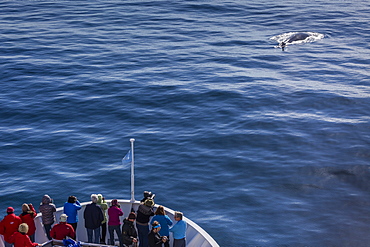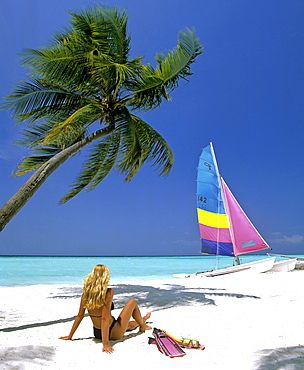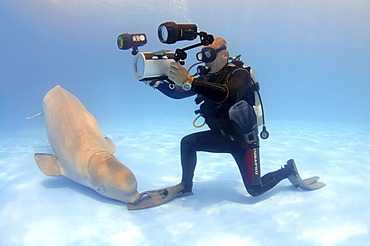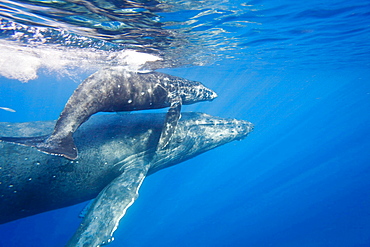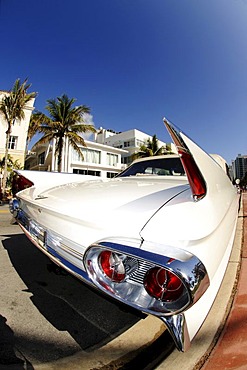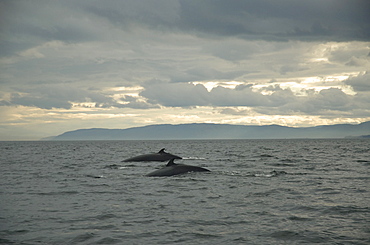Recent searches
Loading...
1112-2614 - A single adult blue whale (Balaenoptera musculus) surfacing in deep water off Funchal, Madeira, Portugal, Atlantic, Europe
1112-2516 - Possible cow and calf fin whale (Balaenoptera physalus) surfacing near Hornsund, Spitsbergen, Svalbard, Arctic, Norway, Scandinavia, Europe
1112-2517 - Adult fin whale (Balaenoptera physalus) surfacing near Hornsund, Spitsbergen, Svalbard, Arctic, Norway, Scandinavia, Europe
1112-2518 - Adult fin whale (Balaenoptera physalus) surfacing near Hornsund, Spitsbergen, Svalbard, Arctic, Norway, Scandinavia, Europe
1112-2585 - Adult fin whale (Balaenoptera physalus) surfacing off the bow of the National Geographic Explorer, Spitsbergen, Svalbard, Arctic, Norway, Scandinavia, Europe
1112-2502 - An adult flying dragon (Draco spp), an agamid lizard, Komodo National Park, Komodo Island, Indonesia, Southeast Asia, Asia
1112-2450 - An adult male mudskipper, subfamily Oxudercinae, displaying to other males on the Hunter River, Kimberley, Western Australia, Australia, Pacific
1112-2459 - Indo-Pacific bottlenose dolphin (Tursiops aduncus), in Yampi Bay, Kimberley, Western Australia, Australia, Pacific
1112-2295 - Adult Moorish idol (Zanclus cornutus), Batu Bolong Island, Komodo Island National Park, Indonesia, Southeast Asia, Asia
1112-2296 - Adult Moorish idols (Zanclus cornutus), Batu Bolong Island, Komodo Island National Park, Indonesia, Southeast Asia, Asia
1112-2281 - Common lionfish (Pterois volitans) at night near the dock of the Komodo Island Diving Resort, Sebayur Island, Komodo Island National Park, Indonesia, Southeast Asia, Asia
934-722 - Reef sharks, Bahamas, West Indies, Central America
934-726 - Lemon shark in the shallow waters in the Bahamas, West Indies, Central America
934-725 - Shark feeding off the beach in the Bahamas, West Indies, Central America
934-721 - Reef sharks, Bahamas, West Indies, Central America
764-4728 - Sandstone fins at sunrise, Coyote Buttes Wilderness, Vermilion Cliffs National Monument, Arizona, United States of America, North America
934-678 - Snapper in  HDR image shot in the Turks and Caicos Islands, West Indies, Central America
832-371828 - Children on the beach, Laguna Resort, The Maldives, Indian Ocean
832-371830 - Woman with two children on the beach, Laguna Resort, The Maldives, Indian Ocean
832-371823 - Woman and two children on the beach, Laguna Resort, The Maldives, Indian Ocean
832-368836 - Young woman with snorkeling gear on sandy beach, catamaran and palm tree, Maldives, Indian Ocean
832-372244 - Spot-Fin Porcupine Fish (Diodon hystrix) swimming above the sandy bottom, Great Barrier Reef, UNESCO World Heritage Site, Queensland, Cairns, Australia, Pacific Ocean
832-374850 - Short-beaked Dolphins (Delphinus delphis) in the Atlantic, off Algarve, Portugal, Europe
832-367257 - Diver, subglacial diving, ice diving, in the frozen Black Sea, a rare phenomenon, last time it occured in 1977, Odessa, Ukraine, Eastern Europe
832-370677 - Woman with snorkelling equipment on the beach, The Baths on Virgin Gorda island, British Virgin Islands, Caribbean
832-371821 - Woman and two children on the beach, Laguna Resort, The Maldives, Indian Ocean
832-369396 - Female diver with a turtle in the shallow waters off an island, Dimakya Island, Palawan, Philippines, Pacific Ocean
832-367293 - Video-operator and Beluga, White whale (Delphinapterus leucas), dolphinarium, Odessa, Ukraine, Eastern Europe
832-367258 - Preparations for subglacial diving, ice diving in the frozen Black Sea, a rare phenomenon which last occured in 1977, Odessa, Ukraine, Eastern Europe
1174-1924 - An Orca, a killer whale swimming in the ocean in Antarctica
1173-288 - Adelie penguins standing side by side toucing flippers on Paulet Island, Antarctica, Paulet Island, Antarctica
1173-289 - A pair of Adelie penguins in the late afternoon light in Antarctica, Antarctica
971-60 - Lunge-feeding fin whale (Balaenoptera physalus) showing distended throat grooves, Northeast Atlantic, off Morocco, North Africa, Africa
489-1531 - Tail fin and rear lights of 1959 Cadillac Eldorado, Melbourne, Victoria, Australia, Pacific
832-342234 - Eurocopter EC 135, helicopter of German Federal Police, Fenestron Impeller in fin
832-302618 - Rock formation Kannesteinen, Sogn og Fjordane, Norway
832-293041 - Palm tree, beach, snorkeling gear and boat, Maldives, Indian Ocean
762-663 - Sandstone Fins, rock formations, Devils Garden, Arches National Park, Utah, United States of America, North America
1113-95757 - Man diving into the water to go snorkelling, Saint Regis Bora Bora Resort, Bora Bora, Society Islands, French Polynesia, Windward Islands, South Pacific
1113-95776 - Woman snorkelling, Bora Bora, Society Islands, French Polynesia, Windward Islands, South Pacific
832-259227 - Lufthansa City Jet and a Lufthansa Boeing 747 at the Frankfurt Airport, Frankfurt am Main, Hesse, Germany, Europe
832-258864 - Scuba diver in an underwater cave with amphoras, Mediterranean Sea, Turkey
832-253777 - Flippers for divers and snorkellers at a diving station, Great Barrier Reef, Australia
832-252359 - Whale fin in front of Space Needle, City Center, night shot, Seattle, U.S state of Washington, USA, North America
1161-7015 - Freshly-caught live oysters, fin de claires, on sale at food market at La Reole in Bordeaux region of France
1161-7009 - Freshly-caught mackerel fish on sale at food market at La Reole in Bordeaux region of France
1161-7019 - Freshly-caught eels, anguilles, on sale at food market at La Reole in Bordeaux region of France
1161-7962 - Whale tail fin in the Golfo Nuevo in Patagonia, Argentina, South America
1161-7010 - Freshly-caught red fish, Grondin, on sale at food market at La Reole in Bordeaux region of France
1161-7014 - Freshly-caught live oysters, fin de claires, on sale at food market at La Reole in Bordeaux region of France
1161-3808 - Sharks fins on sale in shop in Wing Lok Street, Sheung Wan, Hong Kong, China
1161-3799 - Sharks fins on sale in shop in Wing Lok Street, Sheung Wan, Hong Kong, China
1161-3807 - Shark fins on sale in shop in Wing Lok Street, Sheung Wan, Hong Kong, China
1161-3800 - Sharks fins on sale in shop in Wing Lok Street, Sheung Wan, Hong Kong, China
1161-37 - A young Southern Elephant Seal (Mirounga leonina) lying open-mouthed amongst the seaweed on the shores of Sea Lion Island, Falkland Islands, South Atlantic.
1112-1202 - Adult fin whales (Balaenoptera physalus) surfacing off the west coast of Spitsbergen, Svalbard, Norway, Scandinavia, Europe
1112-1203 - Adult fin whale (Balaenoptera physalus) surfacing off the west coast of Spitsbergen, Svalbard, Norway, Scandinavia, Europe
1112-1199 - Adult fin whale (Balaenoptera physalus) surfacing near Gosbergkilen, Spitsbergen, Svalbard, Norway, Scandinavia, Europe
1112-1201 - Adult fin whale (Balaenoptera physalus) surfacing near Gosbergkilen, Spitsbergen, Svalbard, Norway, Scandinavia, Europe
1112-1200 - Adult fin whale (Balaenoptera physalus) surfacing near Gosbergkilen, Spitsbergen, Svalbard, Norway, Scandinavia, Europe
1161-1147 - Magellanic Penguin showing natural oil on its feathers at Sea Lion Island, Falkland Islands, South Atlantic.
869-4152 - humpback whale A mother and calf surface off the island of Maui Hawaii
869-4165 - lemon shark late day light and a shark underwater with remoras West End Grand Bahamas Atlantic Ocean
869-4176 - lemon shark fisheye lens view of sharks attracted to the boat with bait West End Grand Bahamas
869-4169 - humpback whale Breaching Humpback whale Megaptera novaeangliae Hawaii
869-4168 - lemon shark A photographer diver looks on at this shark underwater with remoras West End Grand Bahamas Atlantic Ocean
869-4154 - humpback whale breaching whale in front of Lahaina Maui Hawaii
869-4155 - humpback whale whale calf leaves it's mother for a close look at the camera Hawaii
869-826 - humpback whale tail fin or fluke of diving whale above sea surface water running off fluke in front of mountains at sunset cetacean cetaceans identification profile fluke margin margins one animal only horizontal format
832-198488 - 1905 school classroom, Zuiderzee museum, Enkhuizen, North Holland, Netherlands, Europe
1112-1093 - A small pod of Type B killer whales (Orcinus orca) in Neko Harbor, Andvord Bay, Antarctica, Southern Ocean, Polar Regions
1112-1094 - A small pod of Type B killer whales (Orcinus orca), near Cierva Cove, Antarctica, Southern Ocean, Polar Regions
832-189632 - Chevrolet with tail fins, Ocean Drive, Miami South Beach, Art Deco district, Florida, USA
832-189635 - Chevrolet with tail fins, Ocean Drive, Miami South Beach, Art Deco district, Florida, USA
1112-1049 - Antarctic Minke whale (Balaenoptera bonaerensis), Booth Island, Antarctica, Southern Ocean, Polar Regions
1112-1065 - Type A killer whales (Orcinus orca) travelling and socializing in Gerlache Strait near the Antarctic Peninsula, Southern Ocean, Polar Regions
1112-1050 - Antarctic Minke whale (Balaenoptera bonaerensis), Booth Island, Antarctica, Southern Ocean, Polar Regions
1112-1062 - Type B killer whales (Orcinus orca) travelling and socializing in Lemaire Channel near the Antarctic Peninsula, Southern Ocean, Polar Regions
1112-1066 - Type A killer whales (Orcinus orca) travelling and socializing in Gerlache Strait near the Antarctic Peninsula, Southern Ocean, Polar Regions
1112-1064 - Type A killer whale (Orcinus orca) bull, traveling and socializing in Gerlache Strait near the Antarctic Peninsula, Southern Ocean, Polar Regions
1112-1063 - Type A killer whales (Orcinus orca) travelling and socializing in Gerlache Strait near the Antarctic Peninsula, Southern Ocean, Polar Regions
817-438220 - Healthy, fit female heads out to snorkel at Olowalu, Maui, Hawaii
990-181 - A group of Finback whales (Balaenoptera physalus) surfaces right beside two whale watching boats. St. Lawrence estuary, Canada
990-139 - The Indian summer colours the tree line along the coast indicating the oncoming winter. A sign that Minke whales (Balaenoptera acutorostrata) should start their migration south to unknown waters. St. Lawrence estuary, Canada
990-179 - The blueish colouration pattern of Blue whales (Balaenoptera musculus) is used for photo-identification. St. Lawrence estuary, Canada
990-161 - Steering with its pectoral fins the friendly Minke whale (Balaenoptera acutorostrata) turns its streamlined body towards the boat in order to dive under the hull. St. Lawrence estuary, Canada. Sequence 5/6
990-180 - She canÃt be more trusting than that. A curious Minke whale (Balaenoptera acutorostrata) has turned upside down exposing her white belly, navel and genital slits to the photographer. St. Lawrence estuary, Canada
990-159 - The white flipper band of a Minke whale (Balaenoptera acutorostrata) is visible through the greenish water. This distinctive feature is characteristic of Minke whales of the northern hemisphere and the most obvious difference to their relatives in the Antarctic. St. Lawrence estuary, Canada
990-170 - The distinctive colouration pattern of a Minke whale (Balaenoptera acutorostrata). Note that the typical white flipper band extends on to the lower side of the pectoral fin. St. Lawrence estuary, Canada (RR)
990-173 - Tall dorsal fin of a Finback whale (Balaenoptera physalus) which is located far back along the dorsal ridge. This prominent feature is often used for identification. St. Lawrence estuary, Canada
990-153 - Although largely solitary animals, certain individual Minke whales (Balaenoptera acutorostrata) of the St. Lawrence estuary, Canada, have started to form pairs in recent years. Reasons for this are not yet well understood.
990-150 - ItÃŒs all about being fast and agile when hunting small schooling capelin, the main prey of Minke whales (Balaenoptera acutorostrata) in the St. Lawrence estuary, Canada
990-145 - Very slowly, a curious Minke whale (Balaenoptera acutorostrata) surfaces spreading its pectoral fins perpendicular to its body. St. Lawrence estuary, Canada
990-171 - Tiny water droplets catch the last light of the setting sun as this Finback whale (Balaenoptera physalus) exhales blasting the air compressed in its huge lungs high into the air. St. Lawrence estuary, Canada
990-124 - Harbour porpoise (Phocoena phocoena) arching its back to dive just as its giant relatives do. However, these small cetaceans donÃŒt dive as deep. St. Lawrence estuary, Canada (RR)
990-125 - Very rare photograph of a curious Harbour porpoise (Phocoena phocoena) visiting the research vessel. St. Lawrence estuary, Canada (RR)




